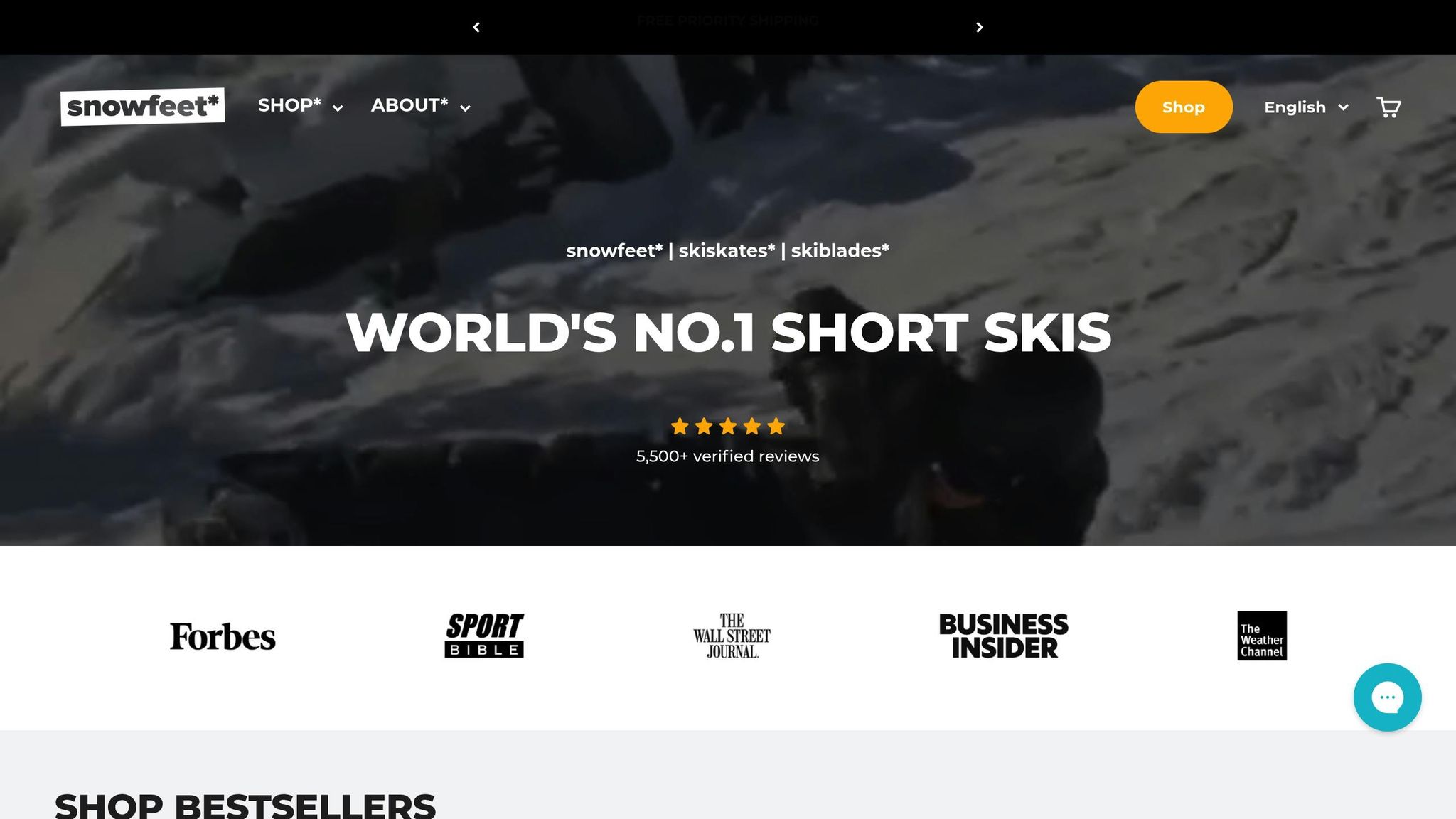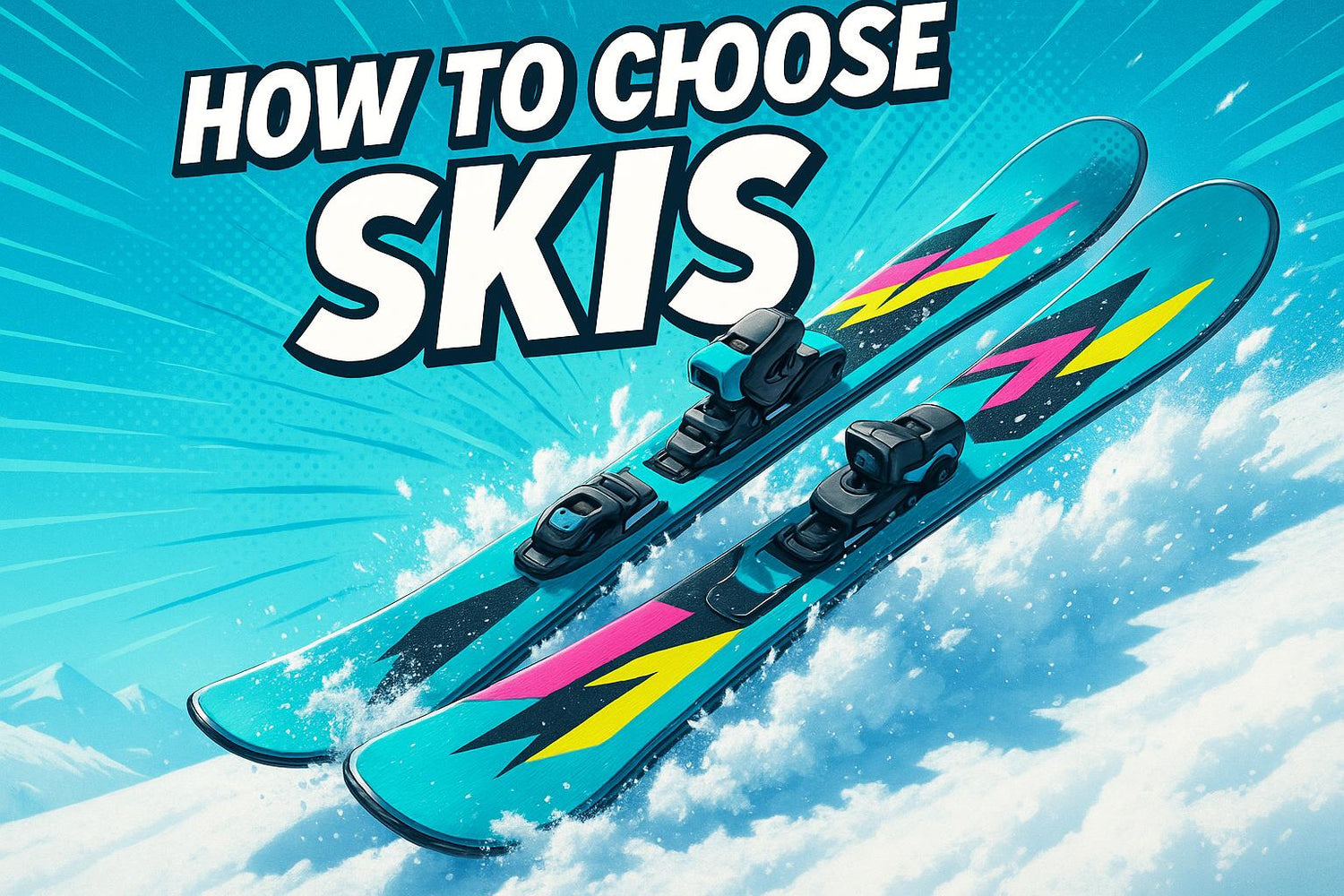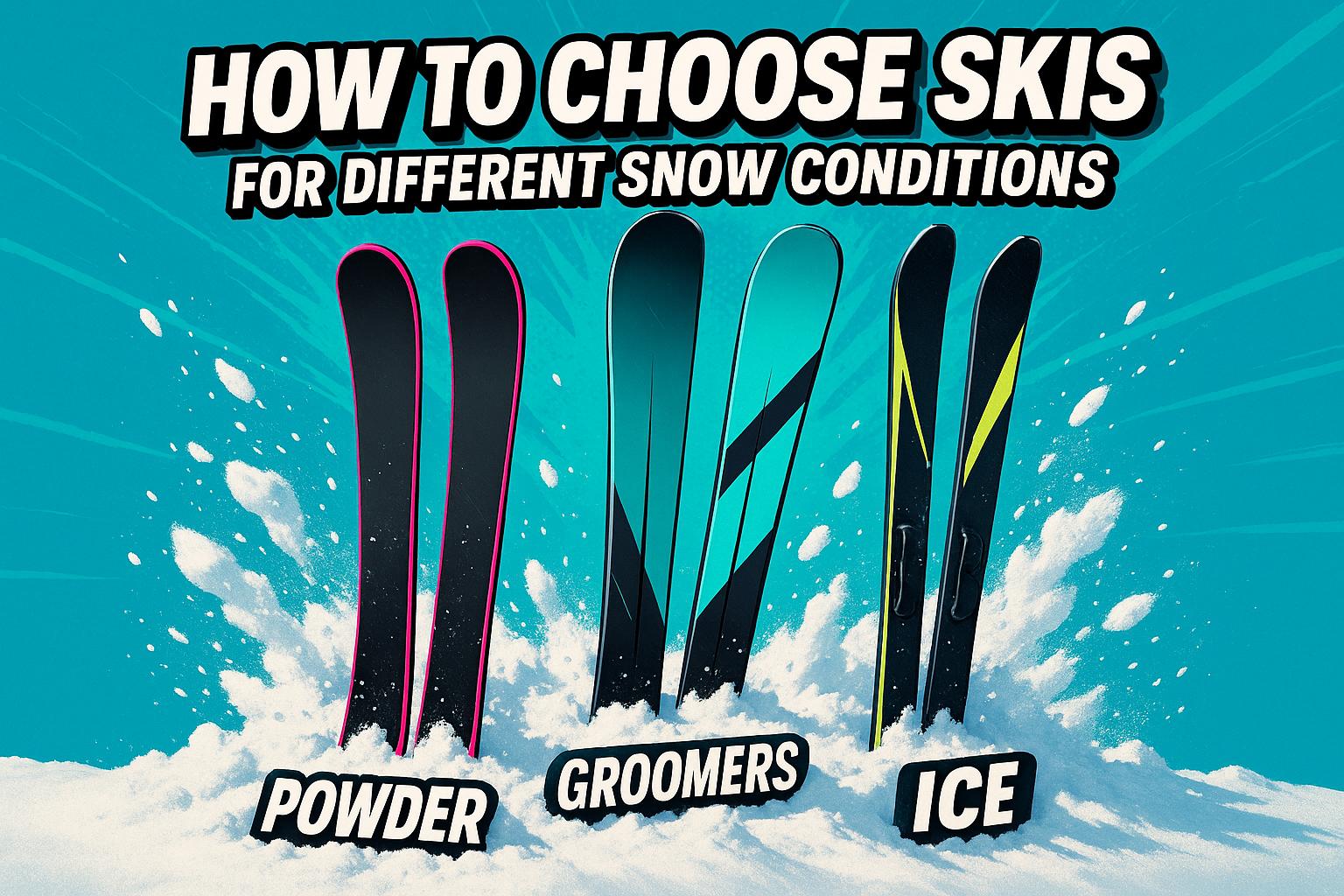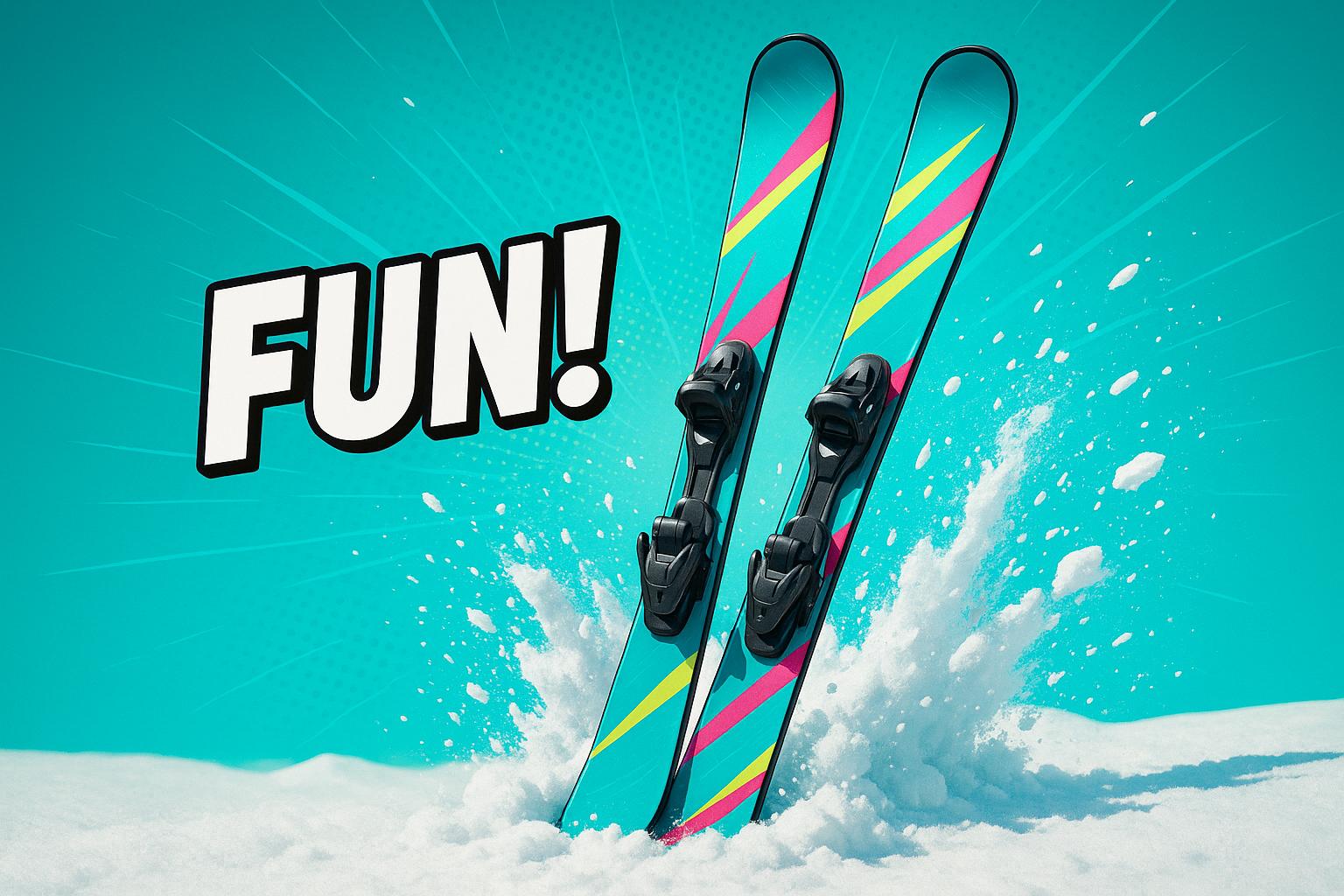Vous voulez des skis performants à la fois sur pistes damées et en poudreuse légère ? Les skis courts, comme les Skiblades (99 cm) de Snowfeet, révolutionnent le ski sur terrain mixte. Ils sont plus faciles à tourner, plus légers à porter, et plus adaptés aux débutants que les skis longs traditionnels. Voici pourquoi ils pourraient être le choix parfait pour vous :
- Agilité : Les skis courts excellent dans les virages serrés, les bosses et les passages en forêt.
- Portabilité : Compacts et légers, ils sont faciles à transporter et à ranger.
- Polyvalence : Parfaits pour les pistes damées, la poudreuse légère, et même les snowparks.
- Contrôle Sans Effort : Moins de fatigue physique, rendant le ski plus amusant et moins épuisant.
Comparaison Rapide : Snowfeet Short Skis vs. Skis Longs Traditionnels

| Caractéristique | Snowfeet Short Skis (38–120 cm) | Skis Longs Traditionnels (150–200+ cm) |
|---|---|---|
| Virage | Virages rapides et serrés | Virages larges et lents |
| Portabilité | Léger, adapté au sac à dos | Volumineux et plus difficile à transporter |
| Courbe d'apprentissage | Facile pour les débutants | Plus raide pour les débutants |
| Stabilité à la vitesse | Modérée, meilleure pour les descentes tranquilles | Haute, idéale pour le ski rapide |
| Performance en poudreuse | Gère la poudreuse légère | Excelle en poudreuse profonde |
Les skis courts simplifient le ski, permettant à tous les niveaux de profiter des terrains mixtes. Que vous glissiez sur des pistes damées ou exploriez des zones hors-piste légères, les skis courts comme les Snowfeet Skiblades offrent la flexibilité et le contrôle dont vous avez besoin.
Un snowboarder essaie Snowfeet* | Quel Snowfeet* Short Ski est le meilleur ? | Test des Snowblades 44, 65, 99
Facteurs clés à considérer lors du choix des skis
Choisir les bons skis pour les pistes damées et les aventures hors-piste repose sur trois critères principaux : leur performance sur différents terrains, leur facilité de transport et leur adaptation à différents niveaux de compétence.
Performance sur le terrain
Skier sur un terrain mixte signifie que votre équipement doit gérer un peu de tout sans trop vous faire de compromis. Les skis longs traditionnels, comme ceux des marques telles que Head ou Elan, peuvent briller sur de larges pistes damées mais paraissent maladroits dans des conditions plus étroites ou changeantes rapidement.
Pour une véritable polyvalence tout-terrain, les skis avec une largeur au patin de 70 à 90 mm sont idéaux. Ils sont assez agiles pour les pistes damées tout en offrant une surface suffisante pour gérer la poudreuse légère. Les skis plus larges excellent généralement en poudreuse profonde, tandis que les plus étroits sont conçus pour le carving à grande vitesse sur neige dure.
Les skis plus courts ont naturellement un rayon de virage plus serré - généralement moins de 15 m - ce qui les rend parfaits pour des mouvements rapides et précis dans les bosses, les passages étroits entre les arbres ou la neige imprévisible. En revanche, les skis plus longs nécessitent souvent des virages plus larges, ce qui peut les rendre moins réactifs en terrain technique.
Prenez par exemple les Snowfeet* Skiblades 99 cm. Ils trouvent un excellent équilibre - offrant assez de surface pour la stabilité tout en restant assez agiles pour les terrains mixtes. De plus, la taille de vos skis n’affecte pas seulement la performance ; elle joue aussi un grand rôle dans la facilité de manipulation hors des pistes.
Portabilité et commodité
Soyons honnêtes : les skis traditionnels de longueur complète sont un vrai casse-tête à transporter. Ils sont encombrants et peuvent être difficiles à gérer dans des espaces restreints.
C’est là que les produits Snowfeet* se démarquent. Les Mini Ski Skates, par exemple, ne mesurent que 38 cm et peuvent tenir dans un sac à dos standard. Même les Skiblades, à 99 cm, sont bien plus faciles à transporter que les skis conventionnels.
"Pensez à Snowfeet comme des patins pour la neige - ils sont légers, portables et faciles à fixer à vos chaussures d’hiver." – Équipe Snowfeet
Cette portabilité n’est pas seulement une question de commodité - elle vous fait aussi économiser de l’énergie. Moins de temps et d’efforts passés à transporter votre équipement signifie plus d’énergie pour skier. De plus, le design compact des skis plus courts les rend plus faciles à manipuler, ce qui est particulièrement utile pour les skieurs de tous niveaux.
Courbe d'apprentissage et niveau de compétence
Les short skis sont adaptés aux débutants tout en offrant beaucoup aux skieurs plus expérimentés qui affrontent des terrains variés.
"Les skis plus courts sont généralement plus faciles pour les débutants car ils sont plus faciles à contrôler et à tourner. Les skis plus longs conviennent mieux aux skieurs plus expérimentés car ils offrent plus de stabilité et de vitesse. Donc, si vous débutez, optez pour des skis plus courts." – Snowfeetstore.com
Prenez par exemple le Snowfeet* WALKSKI 100 cm. C’est un excellent compromis, offrant à la fois stabilité et maniabilité, ce qui en fait un choix solide pour les skieurs intermédiaires qui veulent explorer au-delà des pistes damées.
Les skis plus courts ont aussi tendance à être plus flexibles et tolérants, ce qui est un gros plus si vous peaufinez encore votre technique. Contrairement aux skis plus rigides et longs, ils sont moins punitifs quand vous faites de petites erreurs, vous offrant une glisse plus douce et plus agréable.
Short Skis vs. Skis Longs Traditionnels : Une comparaison directe
Lorsque vous affrontez un terrain mixte, avoir le bon équipement peut faire toute la différence. Les short skis Snowfeet* brillent dans les zones où les skis longs traditionnels peuvent sembler encombrants.
Avantages des Short Skis (Snowfeet*)
Les short skis Snowfeet* sont conçus pour l'agilité. Avec des longueurs allant de 38 cm à 120 cm, ils permettent des virages rapides et précis sur des pentes étroites. Ils sont aussi bien plus faciles à transporter comparés aux skis traditionnels plus encombrants de 150 à plus de 200 cm.
Un autre avantage majeur ? Ils sont moins exigeants pour votre corps. Les short skis demandent moins de pression sur les genoux pour engager les carres, rendant le carving ou les virages plus fluides et moins fatigants. Leur conception tolérante vous aide à vous sentir à l'aise dès le départ.
La polyvalence est un autre point fort. Les Snowfeet* short skis offrent de bonnes performances dans une variété de contextes – que vous glissiez sur des pistes damées, que vous fréquentiez le snowpark, que vous slalomiez entre les bosses, ou même que vous exploriez des conditions légères hors-piste. De plus, leur position naturelle réduit la fatigue, vous donnant plus d'énergie pour profiter de votre journée.
Oh, et voici un bonus : leur taille compacte signifie qu'ils peuvent tenir dans un sac à dos classique. Fini de trimbaler du matériel encombrant.
Voyons maintenant les défis liés aux skis longs traditionnels.
Inconvénients des skis longs
Bien que les skis longs traditionnels aient leurs points forts – comme une stabilité accrue à grande vitesse et une meilleure performance en poudreuse profonde – ils présentent aussi des défis, surtout sur un terrain varié. Leur taille et leur poids les rendent plus difficiles à transporter et moins pratiques lors des transitions entre différentes zones de la montagne.
La maniabilité est un autre problème. Les skis longs nécessitent des virages plus larges et plus d'effort pour les contrôler, ce qui les rend moins efficaces dans des espaces étroits comme les bosses ou les passages entre les arbres. Ils conviennent mieux aux skieurs avancés qui ont la force et la compétence pour les maîtriser.
De plus, l'effort physique nécessaire pour diriger et déplacer les skis longs peut entraîner de la fatigue, surtout lors d'une journée complète sur les pistes.
Tableau comparatif : Snowfeet* Short Skis vs. Skis longs traditionnels
| Caractéristique | Snowfeet* Short Skis | Skis longs traditionnels |
|---|---|---|
| Longueur | 38–120 cm | 150–200+ cm |
| Maniabilité | Élevé – virages rapides et serrés | Plus faible – nécessite des virages plus larges |
| Portabilité | Élevé – compact et léger | Faible – encombrant et plus difficile à transporter |
| Courbe d'apprentissage | Facile – adapté aux débutants | Raide – mieux pour les skieurs avancés |
| Effort physique | Faible – moins de force nécessaire | Élevé – plus d'effort requis |
| Polyvalence du terrain | Super – gère les conditions mixtes | Meilleur sur terrain spécifique |
| Stabilité à la vitesse | Modéré – idéal pour des vitesses occasionnelles | Élevé – excelle à grande vitesse |
| Performance en poudreuse | Modéré – gère la poudreuse légère | Excellent – meilleure flottaison |
| Compatibilité des chaussures | Compatible avec les chaussures d'hiver, de snowboard et de ski | Nécessite des chaussures de ski spécifiques |
Cette comparaison côte à côte montre clairement pourquoi les skis courts Snowfeet* sont un choix fantastique pour les terrains mixtes. Ils sont plus faciles à utiliser, très portables et suffisamment polyvalents pour la plupart des conditions. Alors que les skis longs traditionnels excellent dans la poudreuse profonde ou à grande vitesse, ils demandent plus de compétence et d'énergie, ce qui les rend plus adaptés aux skieurs avancés.
sbb-itb-17ade95
Quel modèle Snowfeet* vous convient le mieux ?
Oubliez la corvée de traîner des skis traditionnels encombrants. Les modèles Snowfeet* sont conçus pour vous offrir liberté et contrôle sur les pistes. Selon vos priorités - performance, portabilité ou facilité d'utilisation - il y a une option Snowfeet* parfaite pour vos aventures. Décomposons tout cela pour que vous trouviez votre match idéal.
Snowfeet* Skiblades 99 cm : Le performant polyvalent
Les Skiblades 99 cm sont votre choix idéal si vous cherchez un équilibre entre agilité et stabilité. Parfaits pour affronter les pistes damées et la poudreuse légère hors-piste. Avec 99 cm, ils sont assez longs pour gérer des conditions de neige variées mais assez maniables pour les virages serrés et les pentes modérées. Ils sont proposés à 490 $ et compatibles avec les chaussures de ski et de snowboard, ce qui en fait un choix polyvalent pour différents terrains.
Snowfeet* WALKSKI 100 cm : Votre compagnon de hors-piste
Si vous avez hâte de quitter les stations bondées, le WALKSKI 100 cm est votre billet pour la liberté en hors-piste. Conçus pour l'efficacité en montée et la performance sur neige molle, ces skis légers facilitent la randonnée comparé aux équipements de ski de randonnée traditionnels. La longueur de 100 cm vous offre la surface nécessaire pour la neige profonde, tandis que leur portabilité les rend parfaits pour les sorties de plusieurs jours ou les terrains isolés. Que vous poursuiviez une poudreuse vierge ou exploriez des pistes hors réseau, le WALKSKI est là pour vous.
Snowfeet* Skiskates et Mini Ski Skates : Aventure à taille ludique
Vous voulez quelque chose de compact et ludique ? Découvrez les Skiskates et les Mini Ski Skates. Ils combinent le meilleur du ski et du patinage, ce qui les rend super amusants pour les petites pentes, le ski urbain ou même votre jardin enneigé.
- Mini Ski Skates (38 cm) : Ces petites merveilles tiennent dans un sac à dos classique et commencent à seulement 150 $. Ils sont parfaits pour les débutants ou ceux qui veulent une portabilité ultime.
- Skiskates (44 cm) : Un cran au-dessus en performance, ils restent légers et portables mais offrent un meilleur contrôle pour le carving, les sauts ou les figures. À partir de 390 $, ils disposent d'une construction à noyau en bois et sont parfaits pour les pistes de ski.
Les deux options fonctionnent avec des chaussures d'hiver standard, des boots de snowboard ou des chaussures de ski, donc pas besoin d'équipement supplémentaire. Tout est question de commodité et de plaisir.
Voici une comparaison rapide pour vous aider à décider :
| Modèle | Longueur | Prix | Idéal pour | Avantage clé |
|---|---|---|---|---|
| Mini Ski Skates | 38 cm | À partir de 150 $ | Débutants, ski urbain | Facile à transporter partout |
| Skiskates | 44 cm | À partir de 390 $ | Usage récréatif | Plaisir du skating + ski |
| Skiblades | 99 cm | À partir de 490 $ | Terrain mixte | Excellent équilibre de contrôle |
| WALKSKI | 100 cm | Prix variable | Exploration hors-piste | Léger et efficace |
Quel que soit le modèle que vous choisissez, le matériel Snowfeet* vise à rendre le ski plus accessible et amusant. Que vous partiez en hors-piste avec le WALKSKI, que vous carviez sur les pistes avec les Skiblades, ou que vous filiez avec les Skiskates, vous êtes assuré de passer un bon moment.
Conclusion : Pourquoi Snowfeet* est l'avenir du ski sur terrain mixte
Snowfeet* bouleverse le monde du ski sur terrain mixte d'une manière difficile à ignorer. Pendant des années, l'industrie s'est accrochée à la croyance que les skis plus longs étaient la référence absolue. Mais Snowfeet* prouve le contraire, obtenant des notes constantes de 5,0/5 sur toute sa gamme - des compacts Skiskates de 44 cm aux polyvalents Skiblades de 99 cm. Ces produits montrent qu'un design intelligent peut surpasser la tradition.
Snowfeet* vs. Grandes Marques : Défier la norme
De grands noms comme Rossignol, Atomic, Head et Elan continuent de produire des skis longs et lourds qui demandent un effort pour être maniés dans les passages étroits. Snowfeet*, en revanche, change la donne. Les skis courts apportent un tout nouveau niveau d'agilité, les rendant idéaux pour slalomer entre les arbres, affronter les bosses ou naviguer sur des pistes fréquentées.
Prenez par exemple les Skiblades de 99 cm. Ils sont aussi à l'aise pour tracer sur pistes damées que pour glisser dans une légère poudreuse. Comparez cela aux équipements traditionnels, où il vous faudrait des skis séparés pour les figures en park et les sorties en backcountry. Snowfeet* simplifie tout - un modèle, plusieurs terrains. C'est un vrai pas en avant dans la technologie du ski, alliant commodité et performance d'une manière que les marques traditionnelles peinent à égaler.
Investir dans du matériel moderne et ludique
Snowfeet* ne se limite pas à la performance - il s'agit de rendre le ski plus amusant, accessible et économe en énergie. À partir de seulement 150 $ pour les Mini Ski Skates, leur matériel offre un design de pointe à une fraction du coût des équipements traditionnels. De plus, leur construction légère réduit la fatigue, vous permettant d'explorer les pistes plus longtemps sans vous épuiser.
Ce qui distingue vraiment Snowfeet*, c'est la combinaison du meilleur du skating et du ski pour une expérience fraîche et dynamique. Des caractéristiques comme la construction en bois des Skiskates et les fixations compatibles avec des chaussures d'hiver classiques montrent comment une ingénierie réfléchie peut rendre le ski plus simple et plus agréable.
Les skis courts ouvrent aussi la porte à tous, quel que soit le niveau. Que vous soyez débutant cherchant à trouver votre équilibre ou skieur expérimenté en quête de nouveauté, Snowfeet* facilite l'accès au plaisir. Contrairement aux marques traditionnelles qui segmentent leur matériel en catégories débutant et expert, Snowfeet* prouve qu'un produit bien conçu peut convenir à tous.
L'évolution du ski est claire : les gens veulent du matériel accessible, polyvalent et amusant. Snowfeet* ne se contente pas de suivre cette tendance - il en est le leader. Alors que les grands acteurs de l'industrie prennent leur temps pour s'adapter, Snowfeet* a déjà compris ce que recherchent les skieurs modernes : simplicité, performance et beaucoup de plaisir sur les pistes.
FAQs
Qu'est-ce qui fait des Snowfeet short skis un meilleur choix que les skis longs traditionnels pour le ski mixte sur piste et hors-piste ?
Pourquoi les Snowfeet Short Skis se démarquent
Les Snowfeet short skis apportent une nouvelle dimension au ski, offrant de nombreux avantages par rapport aux skis longs traditionnels - surtout si vous aimez alterner entre pistes damées et sorties hors-piste. Leur construction légère et compacte en fait un vrai plaisir à manier. Virages rapides ? Aucun problème. Espaces étroits comme les passages entre les arbres ou les bosses ? Vous vous sentirez comme un pro en les slalomant avec aisance. Ce type d'agilité change la donne pour affronter les terrains mixtes en toute confiance.
Un autre avantage ? La portabilité. Ces skis sont assez petits pour se glisser dans un sac à dos, vous évitant ainsi la corvée de transporter un équipement lourd et encombrant. Et si vous débutez en ski, leur longueur plus courte les rend beaucoup plus faciles à apprendre. Leur design plus tolérant signifie que vous passerez moins de temps à lutter et plus de temps à profiter des pistes.
Que vous soyez un skieur occasionnel à la recherche de quelque chose de fun et facile ou quelqu'un désireux d'explorer de nouveaux défis, les Snowfeet short skis offrent une grande commodité, adaptabilité et pur plaisir dans un format compact.
Comment les Snowfeet short skis performent-ils dans différentes conditions de neige comparés aux skis traditionnels ?
Les Snowfeet short skis misent tout sur l'agilité et le contrôle, ce qui les rend parfaits pour les pistes damées, la poudre légère et même les snowparks. Avec leur taille compacte (allant de 65 à 120 cm), ils vous permettent d'effectuer des virages rapides et précis, offrant une expérience ludique et flexible en montagne. Ces skis sont une excellente option pour les skieurs occasionnels ou ceux qui recherchent une glisse plus dynamique.
Maintenant, comparés aux skis traditionnels - ces longs skis allant de 150 à plus de 200 cm - les Snowfeet short skis ne sont pas conçus pour la poudreuse profonde ni la stabilité à haute vitesse. Donc, si vous affrontez un terrain extrême en hors-piste, ils ne seront peut-être pas votre meilleure option. Mais c'est là qu'ils excellent : portabilité et polyvalence. Ils sont fantastiques pour les terrains mixtes et pour les skieurs qui privilégient la commodité et le plaisir plutôt que la performance technique extrême. Si vous cherchez une alternative légère et facile à utiliser aux marques comme Rossignol ou Atomic, ces short skis apportent quelque chose de frais et d'excitant sur les pistes.
Les Snowfeet short skis sont-ils un bon choix pour les skieurs avancés qui veulent vitesse et performance dans la neige profonde ?
Les Snowfeet short skis misent tout sur la polyvalence, la portabilité et le plaisir sur les pistes. Ils sont parfaits pour le ski récréatif et la gestion de terrains variés. Leur design compact facilite les virages rapides et les mouvements agiles, idéal pour les skieurs occasionnels. Mais si vous êtes un skieur avancé à la recherche de vitesse élevée ou affrontant de la poudreuse profonde, ils ne seront peut-être pas votre premier choix.
Voici pourquoi : leur taille plus petite signifie moins de contact avec la neige, ce qui peut rendre les choses un peu instables à haute vitesse ou sur des pentes raides et glacées. De plus, comparés aux skis longs traditionnels de marques comme Rossignol ou Atomic, les skis Snowfeet ont une surface plus petite. Cela signifie qu'ils n'offrent pas la même portance nécessaire pour les aventures en neige profonde.
En résumé, les skis Snowfeet brillent par leur praticité et leur fun pour les sorties occasionnelles. Mais pour ceux qui veulent repousser les limites en vitesse ou dans des conditions de poudreuse abondante, les skis longs traditionnels sont probablement la meilleure option.


































Laisser un commentaire
Ce site est protégé par hCaptcha, et la Politique de confidentialité et les Conditions de service de hCaptcha s’appliquent.